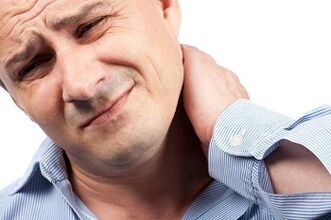
The tendency to grow degenerative-dystrophic lesions of the spine grows steadily every year, and everything because the problem of hypodynamics and hypocinesia is acute due to urbanization.The damage to the cervical spine often causes different intensities of headache and a feeling of stiffness in the neck and in the forearms.Today our topic is the causes, symptoms and the treatment of osteochondrosis of the cervix region.
The reasons for the development of cervix osteochondrosis
If you talk about the causes of degenerative damage to the cervical spine, genetically, toxic, metabolic, endocrine, infectious and others, this can be listed.First and foremost, however, you can sit on a seated lifestyle and on the computer, at the desk and driving.
Frequent loads, which involuntarily represent the attitude of Stoop, which leads to a violation of blood vessels of the nerve neck, help to support this pathology.
Pain symptoms in the neck should not be ignored, as this leads to the progress of the disease and the development of complications such as shoulder -bearing periamphosis, the syndrome of vertebral artery, the front stair syndrome and roying syndrome.
About the anatomical structure
Now let's see which anatomical and physiological characteristics of the structure of the cervical spine contribute to the development and the progress of osteochondrosis:
- The cervix department is the mobest section of the spine.Since all types of movements are possible, this increases the risk of subluxation and frequent violations.
- The vertebral artery takes place in the channel, which is formed in the holes of the transverse processes of the vertebrae.It is bleeding of the brain, auditory organs, the nerve to spine and the cerebellum.With the development of degenerative-dystrophic changes, artery and nerve can clamp in this department.
- In the cervix region, there are no everywhere between the vertebrae.In the front, the vertebrae are connected by joints that can provoke the subluxation of the joints.
- The holes on the three lower cervical vertebrae have a triangular shape, and the growth of bone tissue with osteochondrosis can violate the nerve roots.
- There are vegetative ganglia in the entire cervical department.
These characteristics will help us present the mechanism for the development of complications of osteochondrosis of the cervical spine.
Mechanisms for the development of changes in the cervical spine

The pathological process begins in the intervertebral disc with the loss of moisture with a pulpoose disc disc core.The fibrous ring of the pane gradually becomes thinner, its elasticity decreases and microwaves occur.
As a result, the hard drive loses its ability to repair, dismantle and support.The load of the lower vertebrae gradually increases, according to which the vertebrae is involved in the process.
Small defects occur in IT and osteophytes (excessive bone growth) grow to withstand increased stress.
With the growth of the bone tissue, the nerve roots along the back wall of the vertebra are pressed, and when the vertebral artery is violated on the side surface.
Subluis in the joints appear due to a violation of the stability between the vertebrae.This leads to a compensatory tension of the neck muscles, which contributes to maintaining the cervical vertebrae in a normal position.
When the muscles get tired, the cargo of the vertebrae increases again, which leads to the progress of the disease.A vicious circle is thus formed in which cramping muscles and damaged vertebrae adversely influence each other and lead to a deterioration in the patient's condition.
Based on pathological mechanisms, symptoms of the disease are formed.The squeezing of the nerve roots is shown by intensive paroxysmal pain along the injured nerve.
And when the vertebral artery is compressed, the symptoms occur in connection with a decrease in blood flow in the brain, namely: noise in the ears, dizziness and headache.
The main symptoms of cervical osteochondrosis.
The main symptoms of cervical osteochondrosis are divided into 3 groups:
The first group of symptoms - pain
It manifests itself in the form:
- Local pain in the back/neck;
- The radiation of pain that extends to the right or left and also go to the forearm and even locate the shoulder joints.
This pain can be painful and constant, irritating and spread over the neck or hand.Or it is a more local acute pain pain that appears by clamping the nerve root.
The second group of symptoms are motor disorders
First of all, it is the rigidness of the muscles of the nude and the neck, which is why it is impossible to turn your head normally or tilt or to carry out a movement in the cervical spine.
In addition, this is a restriction of mobility in the shoulder joint, which is called syndrome of the shoulder -pave -periarthrosis.It is also possible to spread over the whole hand, including the deafness of the fingers, the deafness of the hands and deafness along the side surface of the shoulder or forearm.
The third group of symptoms are vegeto-vascular manifestations, manifestations from the vessels
Either a cramp of blood vessels or a pinch in the spine occurs.As a result, such symptoms of cervical osteochondrosis can occur as a headache, dizziness and flickering of "flying" in front of the eyes.
There can also be hearing disabilities - the noise in the ears and the feeling of a "sulfuric pot" in which a person does not hear well.These symptoms are part of the syndrome of vertebral artery.
Methods of traditional treatment of neck osteochondrosis

Modern medicine offers many methods for the treatment of degenerative-dystrophic lesions of the spine.They differentiate between them: drug treatment, manual therapy, folk remedies, therapeutic physical culture (training therapy) and in widespread cases fall back on surgical treatment.The effectiveness of the therapy depends on the stage in which treatment and in a complex selected methods have started.
The treatment should initially aim to normalize the muscle tone of the cervix muscles.The effect of other means aims to eliminate inflammation and pain in the area of the development of pathological changes.
An important point in the treatment of osteochondrosis is a good, comfortable dream for which experts use an orthopedic pillow.
In the early stages of the development of the disease, the use of massages in an experienced specialist and self -massage will be effective.This method helps to relax the cramping muscles and stop the progression of the pathological process.
Medical physical education
The treatment of osteochondrosis should include physiotherapy exercises in the form of gymnastics of therapeutic or morning hygiene.If you carry out a complex of treatment exercises, stick to the following recommendations:
- Pull comfortable clothes and shoes on;
- So that there is no shortness of breath, alternative ordinary breathing exercises;
- The load should gradually increase, and if they started to mark symptoms from the cardiovascular system during the lesson, then stop the exercise and search the doctor.
- When pain in the cervical spine occurred during the lesson, replace them with relaxation and stretching exercises.
- Check your general well, breathing and pulse during the lesson.
- If exercises with hand and stress cause you to pronounced pain, then give up for a while;
- The complex of the physical exercises of therapeutic exercises should be agreed with the doctor.

The following effects are expected from physiotherapy exercises:
- Strengthening the muscles of the neck,
- Blood flow recovery;
- Increased mobility of the vertebrae;
- Increase the movement volume in the cervix region;
- Pain and restore the innovation;
- Prevention of exacerbations.
Drug treatment
Most neuropathologists and other experts do not represent the treatment of osteochondrosis of the cervical spine without medication.The most popular are medication in a group of non -steroidal anti -inflammatory drugs (NSAIDS) that are used in the form of injections, tablets, gels and ointments.
Non -steroid anti -inflammatory drugs relieve pain, inflammation and swelling of the relief.As a result, the tone of the neck muscles is restored, the metabolism in the affected area improves and nerve roots and blood vessels are freed from compression.
It is advisable to use medication from a group of muscle relaxants that also effectively relieve muscle spasms and at the same time restore their sound.However, medication should be used with caution, especially with allergies.

Preparations from the group of corticosteroids have received good checks in the treatment of osteochondrosis of the cervical spine.
The injection agent is very popular due to its anti -inflammatory and neuroprotective effects.
If the treatment described is not effective, use paravertebral blockade with painkillers or steroids.
How to treat cervical osteochondrosis with non -traditional methods
Supporters of non -traditional treatment methods can apply the following treatment methods.
- acupunctureIt helps to save the patient in pain, relieve the swelling and relax the cramping muscles and to eliminate the functional pressing of the nerves and arteries.If your fingers are deaf in your hands, it is advisable to put the needles on the arm in biologically active points and ears.
- Manual therapyIt helps restore normal blood flow in the neck, relieves muscle spasms and frees the nerves.The spine should stretch by an experienced specialist with great caution by an experienced specialist.
- Hirudotherapy (leech treatment)It is an inexpensive and very effective treatment method.The procedure is to place leeches for biologically active points, which should be repeated by a course of 10 sessions.This method contributes to restoring the blood circulation in the cervix region and the relief of swelling and inflammation.
- Top massageIn the fingerfects it insists on biologically active points and helps to relieve muscle cramp, to improve the bloodstream, to relieve swelling, pain and inflammation.
- Folk treatment methodsYou can use it successfully at home.These are different decocements and infusions that can be made by themselves (infusion of wormwood, infusion of lilac, garlic infusion).The therapeutic baths made of mint, chamomile, sage, calamus rhizomes have a good effect.

According to the above-mentioned treatment and convening methods, with the mechanisms of the development of the disease, make a decision to which you can contact your problem: to a neuropathologist or a private clinic.

















































